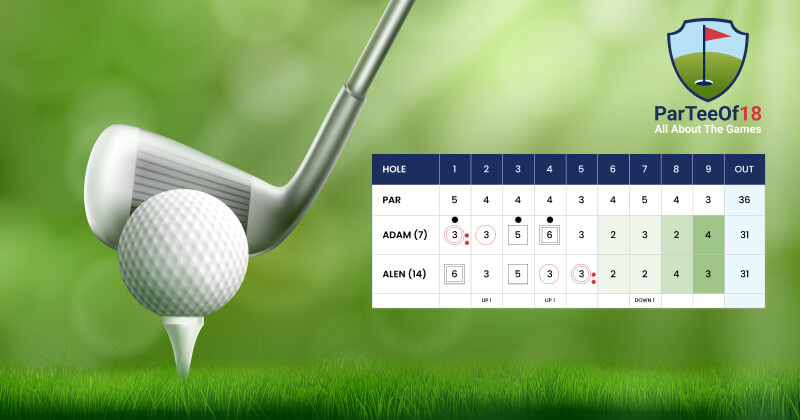Picture yourself on a perfect day: you step on the lush green fairway for an exciting game of golf with sunny clouds and birds chirping all around the course. Hold your horses before your tee-off and sit tight to remind yourself of the basic Golf Tee box rule. This much-needed awareness of tee box rules makes the whole game a lot more exhilarating for everyone involved as you go from tee to green gliding through hazards, squirrels, and bunkers.
Now if you are wondering what are rules ? then you do not need to think about it. You have come across the right blog. In this we will provide a detailed guide on “Golf Tee box rules” in a simplified manner for beginners and experts both. From the tee box , Out of bounds to lost balls as well as water hazards and once you get the understanding of it, the next step is to hit the course and start teeing the ball from one hole to another.
Golf Tee Box Area & Markers Explained Before You Learn the Rules
A golf tee box—also called the teeing area—is the designated spot where each hole begins. It’s where you take your first shot on every hole, and understanding its setup helps you stay within the game’s official limits. Every course has multiple tee boxes based on skill levels or gender—such as the championship tees, men’s tees, and forward tees—so players can choose the right challenge.
What Defines the Tee Box Area
The tee box is formed by an imaginary rectangle. Its front and sides are defined by the position of the tee markers, and the back extends up to two club lengths behind them. Staying inside this boundary is crucial—hitting outside it can lead to penalties under official golf tee box rules. This area ensures fairness and consistency, allowing all players to start each hole from the same conditions.
Golf Tee Markers Explained
Tee markers are small colored indicators placed on the ground, usually in pairs, marking where the tee box begins. Each color often represents a difficulty level or yardage range. For example:
- Blue or black markers: advanced players or tournament tees
- White markers: standard men’s tees
- Red markers: forward or beginner tees
When you tee off, both your ball and stance must stay within the area framed by these markers. This might sound simple, but even a few inches off can violate official regulations.
Pro Tip: Always align your stance parallel to the tee markers and visualize the rectangular zone behind them before setting up. It keeps you penalty-free and improves shot direction.
Official Golf Tee Box Rules (USGA Basics)
Below are the must-know, enforceable Golf Tee Box Rules you’ll face at the tee. I’ll keep this tight and practical—what to do, what to avoid, and the real penalties if you don’t correct a mistake.
Key enforceable rules:
- A hole must be started by playing a ball from anywhere inside the teeing area. If you play from outside the teeing area, consequences differ by format: in match play your opponent may cancel the stroke; in stroke play you incur the general penalty (two strokes) and must correct the mistake.
- A ball is in the teeing area if any part of it touches or is above the teeing area (the rectangular zone defined by the tee markers and up to two club-lengths behind them). You may stand outside the teeing area to play as long as the ball is inside.
- The ball may be teed or played from the ground; non-conforming tees or illegal ways of teeing are penalized.
- You must not move tee markers when playing from the teeing area; if markers are missing seek the Committee or estimate their location responsibly.
- If a teed ball falls off the tee before you make a stroke, you may re-tee without penalty; but once you make a stroke at the ball and it is struck, that stroke counts and the ball is in play.
These points are the core of the official “golf tee box rules” and are what referees and committees will lean on when resolving disputes.
Legal vs Illegal Teeing Positions
| Position | Why it’s Legal | Consequence if Illegal |
|---|---|---|
| Ball partly inside the rectangle (even just a sliver) | Any part of the ball touching the teeing area counts as in play | No penalty |
| Ball entirely in front of the tee markers | Outside the teeing area | Match play: opponent may cancel; Stroke play: 2-stroke penalty + must correct |
| Ball teed up up to two club-lengths behind markers | Within permitted depth of the teeing area | No penalty |
| Playing from wrong set of tee-markers | Ball started from a different teeing location than required | Same as playing from outside teeing area (penalties apply) |
| Ball teed on non-conforming tee (illegal device) | Not allowed under teeing rules | General penalty for breach of Rules |
How This Affects Play (Practical Coach Notes)
- Before you address the ball, check that any part of the ball is inside the rectangle between the markers — that small check prevents big penalties.
- Use the two-club-length depth to your advantage for stance/angle, but don’t step in front of the markers.
- These rules are the backbone of golf tee off rules—know them and your rounds will be less stressful and more by-the-book.
Also Checkout: Essential Golf Putting Tips Every Golfer Should Know
Tee Box Etiquette Every Golfer Should Follow
The tee box isn’t just about the Golf Tee Box Rules — it’s also where good manners and rhythm start. Whether you’re playing a casual round or a tournament, tee box etiquette helps keep the game enjoyable and fair for everyone.
1. Respect Silence and Focus
When another golfer is teeing off, stand still, stay quiet, and avoid distractions like practice swings or phone checks. Even small noises can break concentration and disrupt play. Good etiquette shows respect — something valued as much as a good drive.
Example: When your partner is lining up a shot, step back quietly behind the markers and wait until their swing finishes before moving.
2. Mind Your Position
Stand outside the player’s line of sight, never directly behind or beside them. Position yourself where you’re visible but not distracting. Also, avoid stepping onto the teeing area until it’s your turn — that area should stay neat and undamaged for the next player.
3. Wait Your Turn and Play Promptly
The traditional order of play favors the player with the lowest score on the previous hole to tee off first — often called “honors.” However, under ready golf, it’s acceptable for whoever is prepared to play first when safe. This keeps up the pace of play, which is a big part of tee box courtesy.
Tip: If you’re still getting your club or ball ready, let others go first to avoid slowing the group.
4. Choosing Where to Tee Off in Golf
A major part of tee box etiquette is knowing which tee markers to use. This ensures you’re playing from a distance that matches your ability, keeping the game fair and fun.
- Beginners: Use the forward tees (often red or gold) — shorter holes, faster pace.
- Intermediate players: White tees work well for moderate challenge and yardage.
- Low-handicap or advanced players: Blue or black tees provide full-course difficulty.
- Rule of thumb: Choose tees where you can reach most greens in regulation — not just where others play.
5. Respect the Course
Replace or smooth out any divots made on the tee box. Avoid throwing tees or leaving debris after your shot. The next group deserves the same clean setup you started with.
Also Checkout: What Is Tee Time in Golf? Meaning, Importance, and How to Book
Common Tee Box Mistakes to Avoid
Even seasoned players slip up at the tee box, but beginners tend to repeat a few classic errors. Understanding these helps you stay confident and play by both golf tee box rules and proper tee box etiquette.
1. Teeing Outside the Markers
One of the most common beginner mistakes is teeing in front of or outside the tee markers. This may seem harmless, but it breaks a clear rule — and can cost you penalties.
Fix: Always check that part of your ball is within the rectangle formed by the markers and up to two club lengths behind them. Visualize the box before placing your tee.
Example: If your ball sits even an inch in front of the markers, that’s technically out of bounds for your tee shot.
2. Rushing the Shot
Many new golfers rush to hit their drive before they’re ready or before others have cleared the fairway. Rushing causes poor contact and disrupts pace of play, one of the most overlooked aspects of tee box etiquette.
Fix: Take a calm pre-shot routine—one or two practice swings, align properly, and then swing. It keeps you consistent and respectful to the group behind you.
Tip: If you’re not ready, step aside and let the next golfer hit. That’s good golf rhythm, not hesitation.
3. Distracting Other Players
Talking, moving, or fiddling with tees while someone is addressing the ball is a big no-no. Even small sounds can ruin concentration.
Fix: Stay behind the player’s line of sight and avoid movement until the shot is complete.
Example: Wait until you hear the strike before bending to pick up your broken tee or preparing your ball.
4. Picking the Wrong Tee Box
Some players choose tees that are too long for their driving distance. It makes holes unnecessarily tough and slows play.
Fix: Play from tees suited to your average distance. If unsure, use your Golf Handicap Estimator to decide where you should tee off in golf — it ensures challenge without frustration.
5. Leaving Broken Tees or Trash
Forgetting to clean up broken tees or trash around the area makes the tee box messy for others.
Fix: Quickly collect broken tees after your shot. If you see litter, take a moment to remove it — small actions show big respect for the course.
Quick Recap – Play Smarter from the Tee Box
Understanding and following the golf tee box rules is the foundation of a confident start on every hole. Knowing exactly where you can tee your ball, how far behind the markers you can stand, and maintaining proper order of play ensures you stay penalty-free and respected among fellow golfers. These basics might seem simple, but they define the rhythm and fairness of the game from the very first shot.
Good tee box etiquette goes beyond compliance — it’s about awareness and courtesy. Staying quiet during others’ shots, waiting for your turn, and choosing the correct tees for your skill level all help create a smoother pace of play. When you combine solid setup discipline with respectful habits, you not only boost your confidence but also make the round more enjoyable for everyone on the course.
If you’re ready to take your performance tracking a step further, explore the Golf Scoring App by ParTeeOf18. It helps you log every round, analyze performance, and measure improvement while staying true to the official golf rules. A smarter tee shot starts with better awareness — and the right tools to track your growth on the course.
Also Checkout: 7 Fun Golf Chipping Games to Improve Your Short Game
FAQs
What’s the etiquette for tee boxes?
Proper tee box etiquette means keeping quiet when others are hitting, standing out of their line of sight, and avoiding distractions. Always wait for your turn, repair divots, and respect the pace of play to maintain a positive atmosphere on the course.
What do the different color tee boxes mean in golf?
Different tee box colors represent varying difficulty levels. Forward tees (often red or gold) are for beginners and shorter hitters, while middle (white) and back tees (blue or black) are for advanced or professional players. Always choose the tee box that best matches your skill and distance.
What is the penalty for playing from the wrong tee box?
According to USGA golf tee box rules, teeing off outside the designated area leads to a two-stroke penalty in stroke play. In match play, your opponent can cancel and require you to replay the shot from within the legal teeing area.
What determines which tee box to play from?
Your choice of tee box depends on skill level, driving distance, and overall playing confidence. Beginners or high-handicap golfers should start from forward tees, while experienced players can use middle or back tees for a greater challenge.
What happens if you tee off outside the markers?
If a golfer tees off outside the tee markers, the shot doesn’t count under official golf tee off rules. You must replay the shot from within the legal area and incur the appropriate penalty if applicable.
Can I re-tee after a bad shot?
Yes, you can re-tee your ball if it stays within the teeing area and hasn’t gone out of bounds or into play. However, once you’ve left the tee box and hit a valid shot, any re-tee would count as your next stroke under the golf tee box rules.




